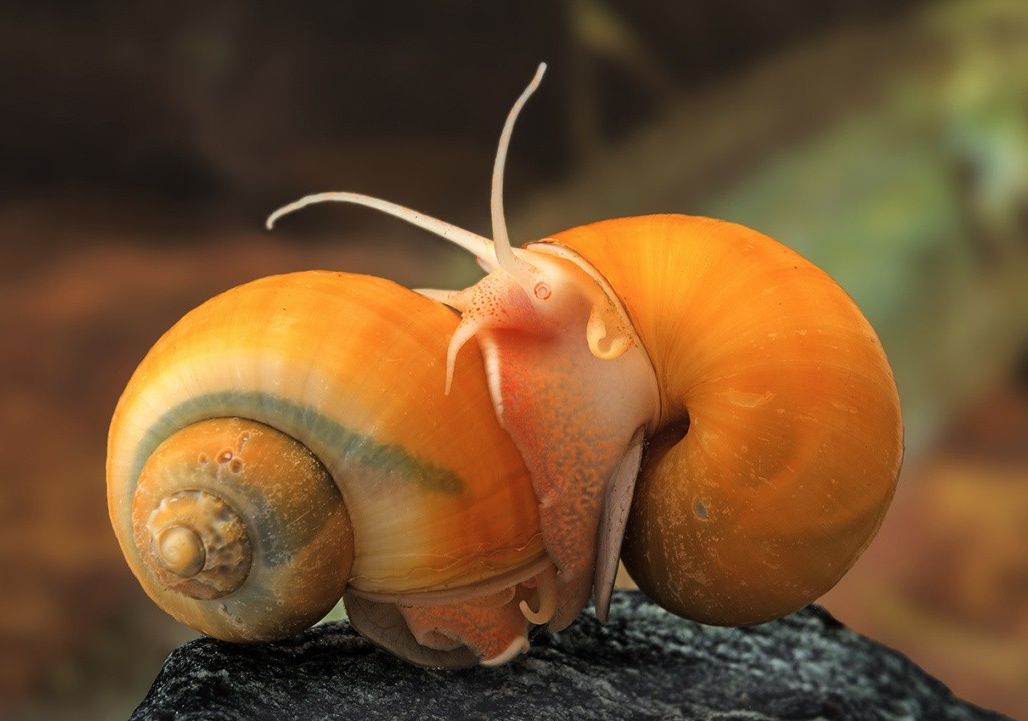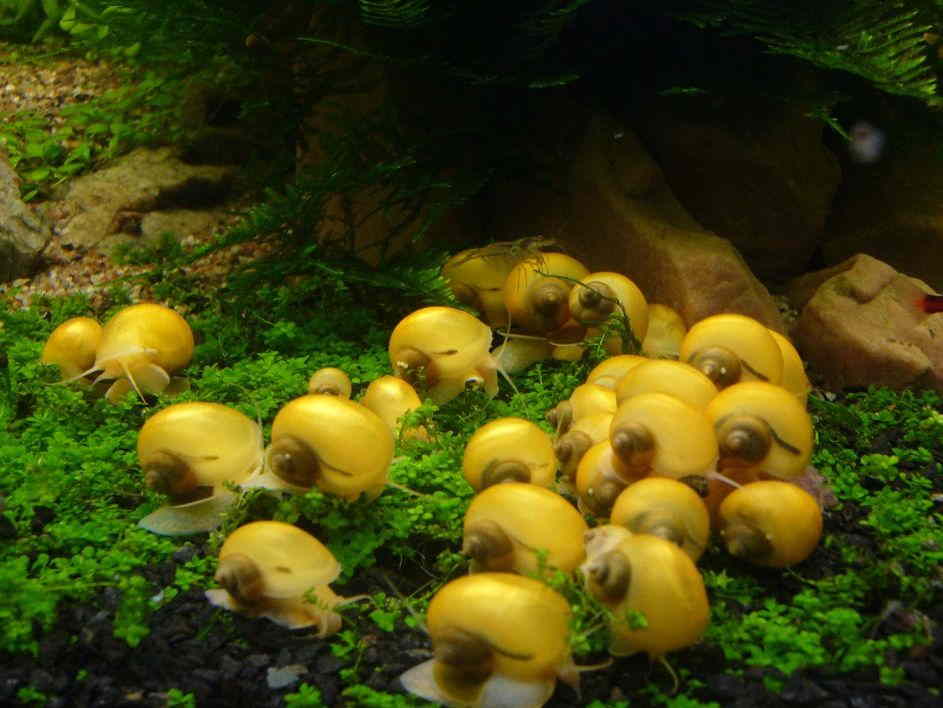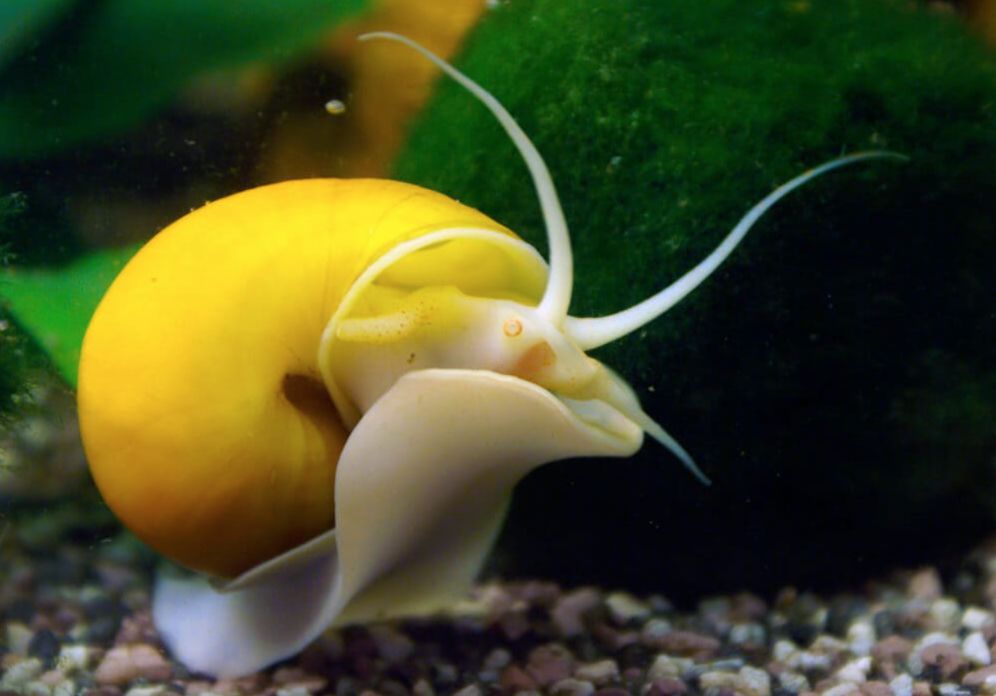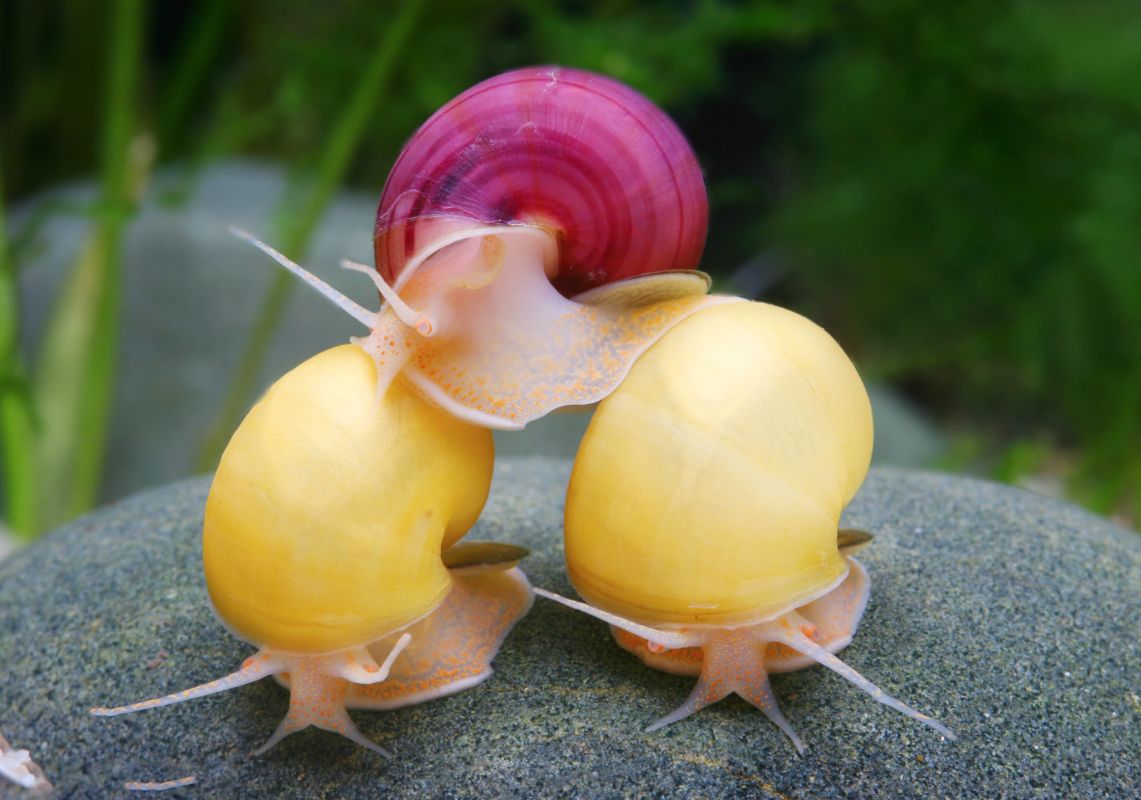Apple snail (Ampullariidae sp.) is a large, bright and very popular tank snail. The term “apple snail” generally refers to a group of large freshwater snails belonging to the family Ampullariidae. The most common name the snail has – mystery snail and golden apple snail; since it can be of different colorings, correspondingly it has different names. However, don’t be confused with such a variety of names. All species despite their differences in appearance are alike in their behavior and care.

Contents
Snails Habitat in the wild
Apple snails, belonging to the family Ampullariidae, are large freshwater gastropods found in tropical and subtropical regions of South America, including Brazil, Argentina, Paraguay, and Uruguay. They inhabit freshwater environments such as rivers, lakes, ponds, and swamps. Notably, the Amazon River hosts a wide range of apple snail species.
While apple snails are beloved in aquariums, they have also been introduced to non-native regions such as parts of Asia, Europe, and North America, including Florida and Hawaii. In these new environments, they have become invasive, causing ecological disruptions and damaging crops. To address this, various regulations and management strategies have been put in place to control their spread.
In their natural habitats, apple snails thrive in slow-moving or stagnant waters rich in vegetation. They prefer areas with dense aquatic plant growth, which provides both food and shelter. They graze on a variety of plants, including floating plants like water lettuce and water hyacinth, as well as submerged plants such as waterweed and hornwort. Apple snails are also known to consume algae, decaying plant matter, and detritus.

Description
The apple snail shell diameter can be up to 7 cm and its “leg” length – 8-10 cm (3-4 in) and width – up to 4 cm (1,57 in). It’s important to remember when you buy an snail that it’s going to grow larger than common snails. Snails are sold being quite small (about 2.5 cm or 1 inch in diameter), but they may grow to be up to 7.5 cm (3 in).
In the wild snail spend most of their life in water and they get out of it only accidentally or during their breeding period to lay the eggs. Still, although they spend the majority of time under the water, they need some atmospheric oxygen to breathe and they go up to the water surface to get it.
Apple snail is capable to get oxygen both from atmospheric air and from water. To do this it uses a special cavity divided with a partition: one part of the cavity is like fish grill and it’s used to breathe oxygen dissolved in water and the other part is similar to lungs.
When reaching water surface the apple snail makes sure that it’s safe and opens its breathing tube (siphon – that is an elongated part of its pallium), and pumps the air inside the lung with rhythmic movements of all its body. An adult snail’s siphon can be about 9-10 cm (4 in) long and the snail itself is rather large.
On a head there are yellowish eyes and two pairs of sense bristles. Snail has very sharp olfaction. That’s why they can smell the feed appearance and surprisingly quickly get to it. Though, the most common coloring is yellow, nevertheless there rather many other colorings. Except, snail one may see white, brown and almost black species.
There are even larger species which were fed well and they become so large that they can even compete in size with another giant – marisa snails.
| Characteristic | Description |
|---|---|
| Scientific name | Pomacea canaliculata (most common) or Pomacea diffusa (also known as mystery snails) |
| Size | Varies depending on the species and age. Can range from 1.5 to 6 inches (3.8 to 15 cm) in diameter. |
| Shell shape | Spherical to conical shell with a coiled structure. |
| Shell color | Can be various shades of brown, green, or yellow. Some species have darker bands or patterns. |
| Body color | Typically light gray or yellowish, with dark spots or patterns. |
| Habitat | Freshwater environments such as rivers, ponds, and marshes. |
| Native range | Originally from South America, but now found in many parts of the world due to human introductions. |
| Lifespan | Typically 1 to 3 years, but can live up to 5 years in optimal conditions. |
| Diet | Omnivorous, feeding on plants, algae, decaying matter, and sometimes small invertebrates. |
| Reproduction | Hermaphroditic (both male and female reproductive organs). Lay eggs in clusters above water. |
| Ecological impact | Considered invasive in some regions due to their ability to reproduce rapidly and outcompete native species. |
| Behavior | Active mainly during the day. Can be seen floating on the water’s surface or climbing on vegetation. |
| Adaptations | Have a trapdoor-like operculum to seal the shell when withdrawn. They can also breathe air using a siphon. |


Care and keeping in the tank
Tank size
The tank size for apple snails will depend on the number of snails you plan to keep and the size of the snails themselves. If these snails are kept alone, a quite small tank will be enough for them – about 5 gallons (19 liters) capacity. Generally, a larger tank is preferable to provide ample space for the snails to move around and thrive.
If you plan to keep multiple snails together, it’s important to provide more space to accommodate their size and activities. For two to three snails, a tank size of 10 to 15 gallons (38 to 57 liters) is suitable. Since they eat a lot of feed and there are a lot of leftovers, it’d be wise to give not less than 5 gallons of tank volume for each snail.
Taking into account the fact that breeding is rather fast thing, it’s not recommended to have a lot of them in a tank. If you intend to breed apple snails, you will need a larger tank to accommodate the adult snails and their eggs. A tank size of 20 gallons (76 liters) or more would be appropriate for a breeding colony.
Since, it happens rather seldom when are kept without any tank mates in a tank, it’s better to expect the tank to be large. Because, for 3-4 apple snails plus some fishes you’ll already need a tank about 20 gallons capacity.
Of course, everything depend on your personal conditions and details. But the rule – 5 gallons for one snail won’t let you down when counting a tank size.
Tank setup
Use a tight-fitting lid or cover for the tank to prevent escape, as apple snails are skilled climbers. Include various decorations such as rocks, driftwood, and live or artificial plants. These provide hiding spots, surfaces for grazing, and climbing opportunities for the snails.
Water parameters
Apple snails prefer a water temperature between 70°F and 82°F (21°C to 28°C). It’s important to maintain a stable temperature within this range using a reliable aquarium heater if necessary.
The optimal pH range for snails is around neutral to slightly alkaline, between 7.0 and 8.0. Regularly test the water pH and make adjustments if needed using pH buffers or conditioners. Apple snails can adapt to a range of water hardness levels, but a moderate to slightly hard water (8-15 dGH) is generally suitable.
Filtration
Good water filtration is important to maintain water quality and prevent the buildup of harmful substances. A gentle filter, such as a sponge or HOB (hang-on-back) filter, can be used to provide mechanical and biological filtration without creating excessive water flow that may harm the snails.
Regular partial water changes (about 20% every 1-2 weeks) help maintain water quality and remove any accumulated waste or pollutants. Avoid sudden large water changes, as they can cause stress to the snails.
Feeding
It’s very easy to feed these snails, since they eat almost any type of feed. Besides, that they will eat all the feed that you give, they’ll feed on everything they will be able to find in a tank. The plus of such behavior is that apple snail will eat the leftovers after other tank inhabitants’ meal and these leftovers won’t stay on the bottom and rot spoiling the tank water.
The easiest way to feed the snails is with catfish feed tablets and vegetables. Cucumber, squash, lettuce and even pumpkin are these favorite meal. Algae wafers or spirulina-based pellets designed for herbivorous or omnivorous aquarium inhabitants.
However, two things should be done for sure – boil the vegetables for about couple of minutes before giving them to snail and don’t leave the vegetables in a tank for over a day since the water gets very muddy.
Snail eagerly feeds on live feed – blood worm, tubifex. But they require a clean bottom to get to such feed and in a community tank the feed usually has a chance to fall on the tank bottom.

Breeding
Unlike the majority of tank snails, apple snail aren’t hermaphrodite species and you’ll need a male and female snail for successful breeding.
The best way to get such a couple of apple snails is to buy 3 snails right away, which almost guarantees that a male and female will be among them. When the snails become reproductive, they’ll start breeding themselves – you don’t need to do anything to stimulate them.
How to get that the breeding process is on? During this period male and female will join each other and the male is always on top. After the breeding is over the female gets out of the tank water and lays a big number of eggs above the water surface.
By the way, this way they very often get out of the tank and die. So, cover the tank with a lid! Their eggs are of pale pink color and it has to be above the water not drowning into it, since this way the eggs will die.
Their surface calcinates under the influence of air and baby snails become completely safe. Small snails appear in a few weeks at the condition that outside temperature is 5–81 °F (24–27 °C) and it’s humid enough. Newborn snails are rather large, fully-fledged and they don’t need any special care.
Tank mates
They are totally peaceful, they never deal with fishes or spineless species in a tank. There’s a misthought that they attack fish. But it has occurred because apple snail is a scavenger and they feed on dead fish and it looks like the snail has killed the fish. There’s no snail capable to chase, catch and kill a healthy and active fish. However, fishes don’t leave the snails alone.
Fishes can tear snail’s horns as, for example, tiger barbs do or even kill as pufferfish, freshwater clown fish and large cichlid fishes. Some fishes can’t eat large snails, but they’ll totally destroy juveniles.
Such fishes will bite large species whenever possibly, that is still rather bad for them. Spineless species such as prawns and crawfish may also become a problem, because they are perfectly good at pulling out snails from their shells.
| Tank Mate | Compatibility Description |
|---|---|
| Peaceful Fish | Guppies, mollies, platies, tetras, rasboras, and other small, non-aggressive fish can be compatible with apple snails. Avoid aggressive or fin-nipping fish species that may harass or harm the snails. |
| Dwarf Shrimp | Neocaridina or Caridina shrimp species like cherry shrimp, amano shrimp, or ghost shrimp can generally coexist peacefully with apple snails. Observe any interactions and ensure the shrimp have ample hiding spots. |
| Snail Species | Other peaceful snail species like Malaysian trumpet snails, nerite snails, or ramshorn snails can often cohabitate with apple snails without major issues. Be mindful of potential breeding and population control. |
| Bottom-Dwelling Fish | Corydoras catfish, otocinclus catfish, or small loach species can be suitable tank mates. These fish tend to stay near the bottom and are less likely to interact directly with the apple snails. |
| Livebearer Fish | Some livebearer fish, such as swordtails or guppies, can coexist with apple snails. |
FAQ
How fast do apple snails grow?
The growth rate of snails can vary depending on various factors such as temperature, water quality, diet, and individual genetics. However, under optimal conditions, apple snails can grow relatively quickly.
During their early stages of growth, snails experience more rapid growth rates. They can double in size within a matter of weeks when conditions are favorable. However, as they mature, the growth rate slows down.
On average, snails can reach their full size within 6 to 12 months, depending on the species. The size of adult snails can vary significantly, with diameters ranging from around 1.5 inches (3.8 cm) to 6 inches (15 cm), depending on the specific species and individual snail.
How long can apple snails live out of water?
In ideal conditions, they can survive for a few hours to a day out of water. However, prolonged exposure to air can lead to dehydration, stress, and eventually, death. It’s crucial to ensure that snails have access to water to maintain their health and longevity.
If you need to handle or move an snail out of water temporarily, make sure to keep the duration as short as possible and provide a damp environment to prevent dehydration. Always aim to return the snail to a suitable aquatic environment as soon as possible.
Apple snail laid eggs – what should I do?
If you are ok with the fact that the snails will get into a community tank – so, don’t do anything. At constant humidity and temperature the snail juveniles will appear from eggs themselves, they will get into the water and start living on their own. It’s not a problem to take the juveniles out of the tank, but if you like you can put some plastic bottle as an incubator for snails eggs and small snails will fall into it and you’ll be able to take them to the community tank.
How to tell if your apple snail is dead or sleeping?
It’s more likely that the apple snail is dead, at least if it hasn’t been moving for over several days. The easiest way to check it is to smell the snail, but carefully since the smell may be rather strong. Dead snails should be removed from the tank, because they decay very fast and spoil the water.
I have some vegetables to feed apple snails, but the vegetables bob up – what should I do?
Everything is very simple, pin a piece of vegetables on a fork or any stainless object.
Do apple snails eat aquarium plants?
Yes, some snail species may feed on tank plants, especially if they are hungry. How to avoid this? Feed the snails to the full.
Do apple snails breed fast? How to control this process?
This isn’t a problem at all. Firstly, the snails eggs are large and they are somewhere above the water, so it’s rather hard not to see them. Secondly, the juveniles are rather large and you can take them out of the tank with your hands.
Do apple snails need some special place for breeding ?
It’s quite enough for the tank to be closed. There is an ideal place for the eggs in the space between the tank lid and water. And again, it’s better to close the lid, since snails may get out of the tank.
My apple snail is very large. How more will it grow?
Provided with good feed snail species of apple snail kind may grow to be 15 cm (6 in) in diameter. But, usually the are about 5-8 cm (2-3 in) in diameter.
My apple snail has some of its body parts torn off – what should I do?
It’s ok, these snails have a wonderful regenerative capability. As a rule, the lost organ will grow back in about 25 days. It can be a bit smaller in size, but it’ll be completely working. These snails are even capable to regenerate their eyes.
Apple snails in brackish water – how do they stand it?
If salt concentration is risen gradually, the snails are capable to stand a bit brackish water. If while raising salt concentration the snail stopped getting out of its shell, then hurry to decrease the salt level in the water.
Do snails carry disease or parasites?
Yes, they do. There are several types of parasites for which the snails are carriers. However, the snails fight these parasites rather well, since apple snails are much more enduring then they are.
There is one parasite which is dangerous for human and it is nematode (Angiostrongylus cantonensis). Rats are the main circulators of infection and human can get infected if he or she eats raw snails. Very seldom this parasite causes nervous system injury and even death.
But still, there’s nothing to be afraid of, since snails can get infected with this parasite only in the wild where their neighbours are infected gnawing animals. It’s hard to imagine that local snails bred in aquariums could possibly have any contact with such animals. And even though we imagine that this happened, you’ll still have to eat this raw snail to get infected.
Do apple snails go dormant?
Yes, some species do during the dry season in the wild. But in the tank there’s no need for snails to do this.
Why is my apple snails shell of different color in some areas?
This happens because at some moment of time the snail stopped growing (the change of habitat, lack of food, change of water parameters) and once all became ok the snail recovered the previous state of its shell. But the marks were left on the shell. It’s ok, the main thing now is to further provide the snail with good living conditions.
My apple snails shell is cracked. Why so?
To form their shells snails get calcium from water. If you have very old or very soft water, the reason of this problem may be just lack of calcium in the tank water and the snail’s protection, it’s shell, gets cracked.
This can be easily fixed, at least you can change some amount of water in the tank or to put some mineral substances into it to make the water more hard. But please keep in mind, that the apple snails can plug up holes in their shells, but if the tip of their shell disappears it can’t be regenerated. However, the snails can quite live with that.
Empty apple shell in a tank – has someone eaten it?
It’s very likely that the snail died itself. See the kinds of fishes that feed on snails mentioned above. But of the snail died itself, it decays very fast, since it’s all protein.
How long do apple snails live?
The lifespan of Pomacea canaliculata can vary depending on various factors such as environmental conditions, diet, and overall care. On average, apple snails have a lifespan of around 1 to 3 years in captivity. However, under optimal conditions, some individuals may live up to 5 years or even slightly longer.
It highly depends on the tank conditions and temperature. At low temperature apple snails live up to 3 years, at temperature from 25 °C (77 °F) the snail lives only about 12-16 month.
At higher temperatures snails are more active, they grow faster and breed. However, the side effect of such living conditions is accelerated metabolism and, correspondingly, early death. Temperature for keeping apple snails may vary from 18 – 28 °C.
Can apple snails live in ponds?
Sure they can during the summer, since they can live at temperature 18-28 °C.
My apple snails aren’t active, they often stay without any movements. I feed them well, the living conditions are good
If the apple snails aren’t dead (see above how to check this), than it’s ok. The snails themselves are very lazy creatures and they have only two desires to eat or to breed. Correspondingly, if they don’t want anything from these two points – they sleep. Or it’s possible that your tank temperature is low, as we mentioned above.
My apple snail has risen to water surface and swims there? Is it dead?
It’s not for sure, since as it was mentioned above, the snails are lazy enough and because of the fact that they breathe with air which they pump up under their shell, it means that it’s quite possible that they can rise up to the water surface. It’s easy to see if something is wrong with the snail – take it out of the water and if it quickly closes the shell, then it’s quite fine. If the snail is dead, its muscles get relaxed and the snail doesn’t move.
What is apple snails hatching time?
It is from 2 to 4 weeks, depending on the temperature and humidity.
How often do apple snails lay eggs?
Apple snails are known for their reproductive capacity, and they can lay eggs quite frequently under suitable conditions. The frequency of egg-laying can vary depending on factors such as age, environmental conditions, and individual snail health. However, on average, snails can lay eggs every couple of weeks to once a month.
When snails lay eggs, they typically deposit them above the waterline, attaching them to solid surfaces such as tank walls, decorations, or even plant leaves. Each clutch of eggs can contain anywhere from a few dozen to several hundred eggs, depending on the species and the size of the snail.
Apple snails are hermaphroditic, possessing both male and female reproductive organs. This means that a single snail can lay eggs on its own without the need for a mate. However, having multiple snails in the same tank can increase the chances of successful egg fertilization.
If you have apple snails in your aquarium and you’re not intending to breed them, it’s essential to monitor and remove the egg clutches promptly. Otherwise, the eggs can hatch, leading to an increased population of snails in the tank.
How many eggs do apple snails lay?
Apple snails are prolific egg layers and can lay a large number of eggs in a single clutch. The exact number of eggs can vary depending on factors such as the species of snail, the size, and individual reproductive capacity.
On average, apple snails can lay anywhere from a few dozen to several hundred eggs in a single clutch. The eggs are typically laid in gelatinous masses or clusters, with each egg encapsulated within the protective coating.
The size and appearance of the egg clusters can also vary depending on the species. Some snail species produce smaller, more compact clusters, while others may have larger, more spread-out clusters.
Do apple snails breed all year round?
Yes, they breed all year round, but significantly less in winter.